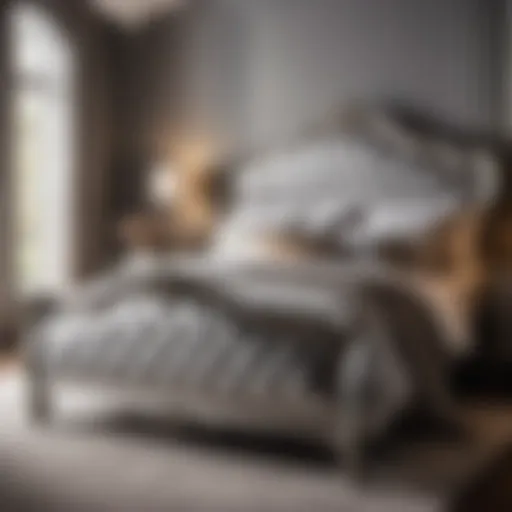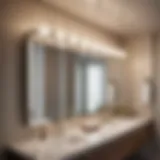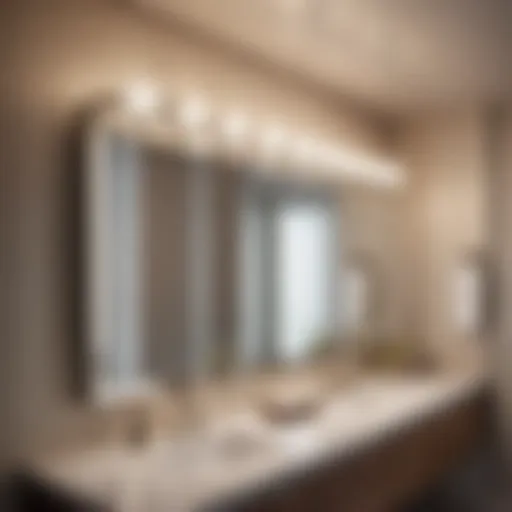The Aesthetic Synergy of Dark Cabinets and Light Countertops


Intro
Achieving an appealing bathroom design demands balancing aesthetics and functionality. One popular choice is pairing dark bathroom cabinets with light countertops. This color combination not only creates striking contrasts but also enhances the perception of space. Understanding the nuances of this pairing is crucial. Homeowners and designers alike benefit from knowing how to work with colors, materials, and layouts effectively.
The transition from planning to execution involves careful selection of materials and thoughtful implementation of design principles. This guide provides a comprehensive overview of everything from sourcing materials to enjoying the completed project, making it invaluable for both DIY enthusiasts and professionals.
Materials:
When embarking on this project, start by gathering all necessary materials. Here's a detailed list to facilitate the process:
- Dark Bathroom Cabinets: Measure the space to select cabinets that fit properly. Standard cabinet size is usually 24 inches deep and 30 inches high.
- Light Countertop: Aim for a countertop that complements the cabinets. Common materials include quartz, granite, or marble, typically 1.5 inches thick.
- Screws and Fixings: Use high-quality screws suitable for cabinetry.
- Construction Adhesive: Ensure durability between cabinet and countertop.
- Paint (if custom paint is desired): Select a color that enhances the overall theme; satin or semi-gloss finishes are ideal for moisture resistance.
- Sealant: Necessary for protecting the countertop from stains and moisture.
- Sandpaper: For smoothing surfaces before painting.
- Primer (if painting cabinets): A bonding primer is crucial for dark finishes.
DIY Steps
With materials in hand, the next step is implementing a clear instructional guide:
1. Prepare the Space
- Clear the bathroom area to make room for the new installation.
- Shut off the water supply if necessary.
2. Install Dark Cabinets
- Ensure the base is level before securing cabinets.
- Mark the wall dimensions to properly align the cabinets.
- Install them according to manufacturer instructions. Use screws to secure firmly into the wall studs.
3. Prepare and Install Countertop
- Place the countertop onto the cabinets, ensuring even coverage.
- Check for proper alignment and make adjustments as needed.
- Apply construction adhesive to secure the countertop.
4. Finishing Touches
- Sand any rough edges and apply paint or stain to cabinets if desired.
- Apply sealant on the countertop after installation to protect it from moisture and stains.
Technical Aspects
Understanding the tools and techniques required for this project can elevate its quality:
Tools Needed:
- Drill with bits for fastening
- Level for ensuring cabinets are straight
- Measuring tape for accurate measurements
- Caulking gun for applying adhesive or sealant
Timing:
Allocate a minimum of two weekends for the entire process. This accounts for preparation, installation, drying, and curing times.
Critical Techniques:
- Ensure precise measurements before cutting any materials.
- Consult tutorials specific to the materials you choose.
DIY Project Process
Sequential Steps:
- Measure: Confirm the measurements multiple times before buying materials.
- Install Cabinets: Follow the leveled markings to install dark cabinets first.
- Affix Countertops: Proper alignment is crucial - always use a level.
- Seal and Paint: Complete the touch-up with sealant and paint as required.
Troubleshooting Tips:
- If cabinets are not level, use shims to adjust.
- If countertop does not sit flush, remove and realign carefully.
Important Note: Take your time. A rushed job can lead to mistakes that are frustrating and costly.
By carefully following these steps, it’s possible to create a bathroom space that reflects personal style and functionality. Consider both the aesthetic and practical implications for a harmonious outcome.
Prelims to Bathroom Design Choices
The bathroom is a vital space in any home, serving both functional and aesthetic purposes. Understanding the choices available in bathroom design can significantly enhance the overall experience one has in this intimate area. The aesthetic synergy of dark bathroom cabinets paired with light countertops provides visual interest and balance, which is crucial in achieving a cohesive look. Homeowners often overlook how varying colors and materials can impact feelings of comfort and serenity in their bathrooms. This overview serves as a foundation for exploring the specific benefits and considerations that arise when integrating these elements into bathroom design.
Importance of Color Psychology in Bathrooms
Color psychology plays a significant role in how spaces are perceived and experienced. In bathrooms, where relaxation is essential, color choices need thoughtful consideration. Dark cabinets can create a grounded and sophisticated atmosphere, while light countertops often evoke feelings of cleanliness and openness. The combination creates a contrast that can balance heaviness with lightness, providing a pleasing visual dynamic.
When choosing colors, it's important to consider personal preference alongside the room's natural light and size. Dark hues can make larger bathrooms feel cozy, while lighter surfaces can help smaller spaces appear more expansive. Understanding these dynamics helps homeowners select colors that not only complement each other but also enhance the overall mood in the bathroom.
Trends in Modern Bathroom Design
Current trends in bathroom design embrace various styles that harmonize luxury and simplicity. Minimalist designs are increasingly favored, leaning towards streamlined shapes and uncluttered spaces. Modern bathrooms often showcase sleek lines and a harmonious color palette, enhancing the overall appeal.
Popular materials such as marble or quartz for countertops remain trendy due to their classic elegance. Dark cabinets made of durable woods or striking laminates provide visual weight without overwhelming the surroundings. This plays into a broader trend of creating a calming spa-like environment at home.
This section highlights the need for homeowners to stay informed about evolving design trends and the significance of making choices that align with their tastes and practical needs. It ensures that each design element chosen contributes positively to the overall aesthetic and functionality of the bathroom.
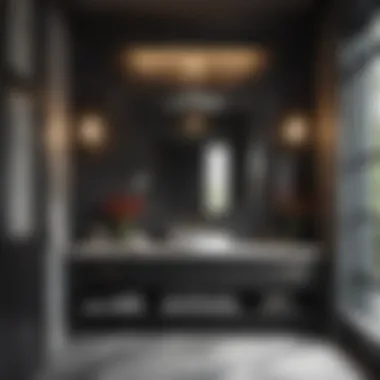

Characteristics of Dark Bathroom Cabinets
The use of dark bathroom cabinets plays a pivotal role in achieving a balanced aesthetic in modern spaces. Their characteristics must be thoroughly understood to make informed design choices. Dark cabinets can evoke a sophisticated atmosphere, creating contrasts that enhance both functionality and style. They can also draw focus to light countertops, making such pairings visually appealing.
When selecting dark cabinets, considerations include the material, finish, and texture, all of which impact the overall look and feel of the bathroom. Dark cabinets can serve multiple roles; they can accentuate bold design choices or provide a subtle backdrop for brighter elements in the space. This balance is essential, especially in smaller bathrooms, where proper visual weight is necessary to avoid overwhelming the space.
Popular Materials for Dark Cabinets
Wood
Wood is a classic choice for dark cabinets. It brings warmth and a natural element into the bathroom. One key characteristic of wood is its versatility in design. Whether oak, mahogany, or walnut, each type of wood offers unique grain patterns and colors.
Wood is a beneficial choice because it can be treated to enhance its durability and resist moisture, a significant advantage in bathroom environments. However, it does require regular maintenance to prevent warping or damage from humidity.
The aesthetic value of wooden dark cabinets cannot be ignored.
Laminate
Laminate offers a cost-effective alternative to wood while mimicking its appearance. The material is composed of a particle board base with a decorative layer on top. A notable characteristic is its resistance to scratches and stains, making it practical for everyday use.
Laminate can come in various finishes that can imitate high-end materials, providing an attractive option that is easy to clean. However, it may not be as durable as solid wood and could look less luxurious in high-end bathrooms.
Metal
Metal cabinets, often made from stainless steel, bring a contemporary feel to bathroom designs. The key characteristic of metal is its high durability and resistance to water damage. This makes it an ideal choice for modern spaces that prioritize functionality.
An advantage of metal cabinets is their low maintenance; they require only regular wiping to keep them looking new. However, they may not provide the warmth associated with wood or laminate options, which could create a colder feel in the bathroom.
Finishes and Textures
Matte vs. Glossy
Choosing between matte and glossy finishes affects the cabinet's overall aesthetic. A matte finish offers a sophisticated and understated look, which can help create a cozy atmosphere. One advantage is that matte surfaces are less likely to show fingerprints or water spots, making them practical for bathrooms.
Glossy finishes, on the other hand, can reflect light effectively and create a striking contrast with light countertops. This reflective quality can enhance brightness in smaller spaces. However, glossy surfaces can show smudges more easily and may require frequent cleaning.
Paint Finishes
Paint finishes introduce various color options, allowing even further customization of dark cabinets. A well-applied paint finish can provide both durability and aesthetic appeal. The choice of paint can significantly impact the mood of the room. Dark cabinets painted in deep hues can create a dramatic look, while lighter shades can soften the space.
However, the durability of paint finishes can vary, and they may require touch-ups or complete reapplication over time.
Stained Options
Stained wood cabinets provide a rich hue that enhances the natural grain. This offers depth and character to the cabinetry. One key benefit of stained options is that they allow for color variation while still showcasing the wood's intrinsic beauty.
Stains can vary from light to dark, allowing for more personal expression in design. Yet, these stains also require ongoing maintenance to keep their appearance intact, especially in humid environments like bathrooms.
Light Countertops: Enhancing Brightness
Light countertops play a significant role in the overall design aesthetic of a bathroom. They bring a sense of airiness and brightness that contrasts beautifully with dark bathroom cabinets. This combination can enhance the visual appeal of the space, creating an inviting atmosphere. Furthermore, light countertops can make a room appear larger and more open, an invaluable quality in smaller bathrooms.
Material Versatility of Light Countertops
Natural Stone
Natural stone, such as marble or granite, offers elegance and durability. Its unique patterns and textures contribute to a luxurious feel in the bathroom. The natural variations in stone ensure that no two countertops are the same, adding a distinct character to each space. However, it can be more porous than other materials, which requires regular sealing to prevent stains and damage.
Quartz
Quartz is an engineered stone that combines natural quartz crystals with resins. It is non-porous, making it resistant to stains and easy to clean. This material is increasingly popular for bathrooms due to its variety of colors and patterns. Quartz can mimic the appearance of natural stone without the maintenance difficulties. However, it may not have the same organic feel as other natural materials, which some homeowners may prefer.
Solid Surface
Solid surface countertops, often made from acrylic or polyester, offer an attractive alternative for bathroom designs. They provide a seamless look with the ability to integrate sinks into the design, creating a unified aesthetic. Solid surfaces are resistant to stains and easy to repair if scratched. One downside is that they may not have the same heat resistance as stone, so care must be taken when placing hot items on them.
Color Variations and Their Impact
White
White countertops are a classic choice that enhances brightness and simplicity in bathroom design. Their versatility allows them to fit into various styles, from contemporary to traditional. Being easy to match with many color palettes, white offers a clean look. However, they can be prone to showing stains and scratches more readily, which might demand extra care in maintenance.
Cream
Cream is a warmer alternative to white that still promotes brightness. This subtle hue adds warmth and complements darker cabinets nicely. Cream tones can soften the overall look of the space, making it more inviting. The downside is that it may not provide as crisp a contrast with dark cabinets as pure white can, potentially losing some of the dramatic effect.
Pastel Shades
Pastel shades, such as soft blues or greens, can evoke a sense of calm and tranquility. These colors add a layer of personality while still maintaining a light and airy vibe. Pastels can work well in bathrooms that aim for a spa-like atmosphere. However, they may limit future design changes since they could be less versatile than white or cream in pairing with new decor.
The juxtaposition between dark cabinets and light countertops is not just about aesthetic appeal; it embodies a deeper design philosophy focusing on balance and harmony in space.


By combining different materials and color options, homeowners can maximize the brightness and expand the aesthetic potential of their bathrooms.
The Contrast Effect: Balancing Dark and Light
The interplay between dark bathroom cabinets and light countertops can significantly enhance the aesthetic value of any bathroom. This contrast is not merely a visual tactic but a strategic design choice that serves to create a more inviting and spacious atmosphere. When executed well, the balance between these two contrasting elements greatly influences not only the appearance but also the functionality of the space.
Visual Appeal of High Contrast
High contrast is often equated with high impact. When dark cabinets meet light countertops, it creates an immediate focal point that draws the eye. This visual appeal is especially crucial in bathroom design, where lighting is often limited. The stark difference in colors essentially allows for highlights and shadows to play off each other, generating a dynamic visual experience. It is important to note how these contrasting shades can work together.
- Attractiveness: The duality of dark and light can enhance the overall attractiveness of the space, making it look modern and sophisticated. Likewise, it gives the illusion of a more expansive area, thereby combating the often cramped feeling of small bathrooms.
- Style Versatility: This combination suits various design styles, from modern and contemporary to traditional. It can be adjusted to fit personal aesthetics while still making a strong visual statement.
"Choosing dark cabinets with light countertops is a classic pairing that should not be underestimated; the visual contrasts create a compelling focal point in even the simplest of designs."
Creating Depth and Dimension
Creating depth and dimension is another benefit of pairing dark cabinets with light countertops. These contrasting colors do more than complement each other; they can also structure the spatial experience within your bathroom. Here are some considerations when thinking about depth:
- Layering: Dark cabinets anchor the space, providing a solid foundation against which the lighter surfaces can stand out. This layered effect can help to delineate areas within the bathroom, such as the vanity from the rest of the space.
- Illumination: The light countertops reflect light more efficiently, which can help to brighten the space. This illumination contrasts with the dark cabinetry, whereby shadows create an inviting, multi-dimensional environment.
- Design Focal Point: Adding accessories or artwork that integrates the dark and light colors can create a cohesive look. By placing decorative elements near the boundaries of these contrasting areas, one can further enhance the sense of depth.
In summary, the balance of dark and light is not just a surface level concern but plays a vital role in shaping the experience and functionality of your bathroom.
Design Styles Complemented by Dark and Light Combinations
The interaction between dark bathroom cabinets and light countertops extends beyond mere aesthetics; it incorporates the essence of design styles that create a cohesive and inviting space. Understanding the various styles complemented by this contrast can aid in establishing a bathroom environment that reflects individual tastes. Moreover, these combinations can enhance functionality while remaining visually appealing. Each design style offers unique characteristics and considerations, providing a solid foundation for the decision-making process in bathroom design.
Contemporary Style
Minimalist Approach
The minimalist approach is defined by its simplicity and functionality. It strips away unnecessary elements, focusing on essential features. In the context of bathroom design, this style promotes a serene environment characterized by clean lines and uncluttered spaces. This approach is beneficial as it maximizes visual space, making smaller bathrooms appear larger and more open.
One unique feature of the minimalist approach is its reliance on neutral color palettes. Dark cabinets paired with light countertops align perfectly with this trend, creating a striking yet calm ambiance. However, an overly simplistic design may lack warmth, necessitating careful selection of accessories to maintain balance in the space.
Geometric Patterns
Geometric patterns introduce an element of dynamism to bathroom designs. They can range from bold shapes to subtle textures that draw the eye. This style stands out due to its ability to create visual interest without overwhelming the overall design scheme. By incorporating geometric elements alongside dark cabinets and light countertops, homeowners can achieve an engaging space that encourages exploration.
A key characteristic of geometric patterns is their versatility. They can be executed through tile designs, wallpaper, or decorative accents. This flexibility allows homeowners to express their personal styles while reinforcing the contrast of dark and light elements. However, excessive use of such patterns may make the space feel chaotic, hence moderation is advisable.
Traditional Style
Classic Fixtures
Classic fixtures embody timelessness and elegance. Incorporating these fixtures into a bathroom design enhances the aesthetic quality of dark cabinets and light countertops. The use of materials like polished chrome or antique brass creates a sophisticated contrast against dark cabinetry, emphasizing their rich tones. Often, these fixtures are visually ornate, adding character without undermining functionality.
The distinct feature of classic fixtures is their ability to endure trends. They provide a sense of history and comfort, making them a popular choice for many homeowners seeking a traditional feel. However, the challenge lies in integrating these elements with modern wants for practicality in maintenance and usability.
Timeless Color Schemes
Timeless color schemes rely on a balanced mix of neutrals, rich hues, and subtle accents. They serve as a foundation for creating a classic atmosphere. In the context of dark bathroom cabinets and light countertops, neutral tones can mellow out the contrasts, making spaces feel inviting and harmonious.
This style often combines tones like beige, taupe, and soft whites, allowing the darker elements to stand out without clashing. The unique advantage is that these schemes can easily adapt to changing preferences, making it a long-lasting solution for any homeowner. Yet, it requires thoughtful coordination to avoid creating an overwhelming appearance, especially when integrating colorful accessories.
Industrial Style
Raw Finishes
Raw finishes celebrate the beauty of unrefined materials. This approach emphasizes authenticity and often features concrete, wood, and metal. Dark cabinets can beautifully embrace this style with their robust appearance. When combined with light countertops, the contrasts become more pronounced, allowing the texture and grain of the materials to shine.
The key characteristic of raw finishes lies in their rugged appeal. This makes them particularly beneficial for spaces aiming for a more relaxed, urban ambiance. However, careful planning is essential to ensure that the raw elements do not dominate the room, as it could lead to an overly cold or harsh environment.
Urban Influences
Urban influences in bathroom design refer to elements that reflect city living, such as exposed piping and modern fixtures. These designs often prioritize functionality while embracing a sleek visual style. Dark cabinets, alongside light countertops, can embody this aesthetic by offering a balance between practical and artistic choices.
Key features of urban influences include a mix of industrial elements with contemporary comforts. This blend can create a space that feels alive and energized. However, overdoing the urban theme may detract from comfort, so it's critical to infuse warmth through decorative elements like plants or textiles.
Practical Considerations for Maintenance
Maintaining dark bathroom cabinets and light countertops requires thoughtful attention. Practical considerations help ensure that these design features not only look good but also last over time. Understanding the nature of different materials and how to care for them increases longevity, saving both time and money. Maintenance routines are essential in preserving the aesthetics of the bathroom, allowing it to remain a space of comfort and beauty.
Cleaning Dark Cabinet Surfaces
Dark cabinets, while stylish, can show dust and fingerprints easily. Regular cleaning is crucial to maintain their appeal. Here are some specific steps for cleaning dark cabinet surfaces effectively:
- Use non-abrasive cleaners: Choose a mild, pH-balanced detergent mixed with warm water. Avoid harsh chemicals that can strip the finish.
- Soft cloths are key: Use a soft microfiber cloth to wipe down cabinets. This will help avoid scratches that may dull the surface.
- Spot cleaning: For stubborn stains, dampen a cloth with clean water and gently scrub. If that does not work, try adding a little bit of baking soda to the water for more abrasive cleaning.
- Regular maintenance: Schedule cleaning routines weekly to prevent build-up. It is easier to maintain cabinets than to deal with heavy cleaning later.
Maintaining Light Countertops
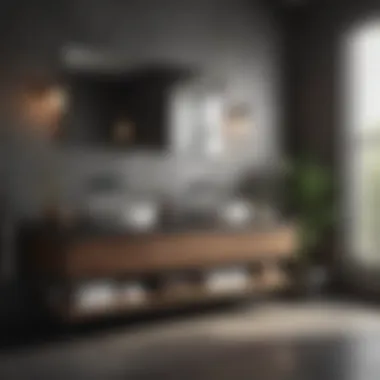

Light countertops are a beautiful choice but can be prone to staining and discoloration. Correct maintenance is essential to keep them looking pristine. Here are effective methods for maintaining light countertops:
- Immediate cleaning: Clean spills quickly to avoid stains. A quick wipe with soap and water is often sufficient.
- Sealant applications: Many light countertops, especially stone, benefit from a sealant. Depending on the material, reapplying the sealant every six months can help prevent staining.
- Use cutting boards: Always use cutting boards when preparing food. This helps avoid scratches that can trap dirt and moisture.
- Avoid harsh chemicals: Instead of using bleach or ammonia-based products, opt for milder cleaners. Acidic substances can degrade the surface over time.
"Regular maintenance not only preserves the beauty of your bathroom but also ensures a welcoming environment for all who use it."
Psychological Impacts of Color Choices
In bathroom design, every color choice carries a significant psychological weight. When homeowners select dark cabinets with light countertops, they are engaging not just with aesthetic considerations, but also with the mental and emotional implications that these colors convey. The selections made can influence how space is perceived, evoke certain moods, and even affect the overall feeling of tranquility or chaos in the room. The interplay between light and dark colors often creates a distinctive environment that can either relax or invigorate its users.
Mood Enhancement through Design
mood within a bathroom can greatly change based on color selection. Dark cabinetry, while sometimes associated with heaviness, can actually create a grounding effect when paired with light countertops. This blend can evoke feelings of sophistication and elegance. The lighter surface can reflect light, making the space feel more open and inviting. Moreover, using colors like soft creams or whites next to deep mahogany or charcoal can enhance feelings of peace and relaxation.
Research indicates that lighter colors are often more calming, which is essential in areas intended for personal care and relaxation. When choosing the right palette, consider the emotional responses elicited by different shades. For example:
- Light blues and greens can promote calmness and serenity.
- Soft beiges can induce a sense of warmth.
- Light grays maintain a modern feel while adding sophistication.
Dark cabinets contribute to stability in this psychological mix. They frame the lighter surfaces and create a balanced aesthetic that can emphasize personal style while providing a calming influence on the users.
Influence on Perception of Space
Color can manipulate spatial perception quite effectively. Typically, dark colors are known to absorb light, which may make a space feel smaller or more intimate. However, when these dark cabinets are combined with light countertops, the contrast plays an essential role in enhancing the sense of space.
This combination can trick the eye into perceiving the bathroom as larger and more visually appealing. The light surfaces act as a counterbalance, reflecting light around the room. Therefore, this synergy does not merely serve aesthetic purposes but also helps in creating a more open environment.
Additionally, careful placement of these elements can direct the flow of movement within the bathroom. For instance:
- Dark cabinets may occupy the base area, creating a solid foundation.
- Light countertops can lead the eye upward, offering the illusion of a taller space.
Together, these design choices elevate the overall experience, making the bathroom not just a functional area but a personalized sanctuary.
"The interaction of color in design goes beyond mere visual appeal; it profoundly influences how a space feels and how we feel in it."
In summary, being mindful about the psychological impacts of color choices in your bathroom can lead to a more satisfying and aligned personal space. The careful combination of dark cabinets and light countertops opens a pathway to achieving notable mood enhancement and a broader perception of space.
Accessories and Accents
The inclusion of accessories and accents in bathroom design is essential to achieving a well-coordinated space. They serve both practical and aesthetic purposes, enhancing the overall ambiance while reflecting personal style. Thoughtfully selected accessories not only complement dark bathroom cabinets and light countertops but also contribute to the functionality and comfort of the environment.
By focusing on specific elements such as complementary fixtures and textiles, homeowners can create a cohesive look that emphasizes the desired aesthetic synergy. Accessories allow for simple updates or complete transformations without major renovations.
Complementary Fixtures
Faucets
Faucets play a crucial role in the overall functionality and style of a bathroom. Choosing the right faucets contributes significantly to the synergy of dark cabinets and light countertops. The key characteristic of modern faucets is their sleek design, which merges well with both contemporary and traditional aesthetics. They are beneficial as they offer various finishes, such as polished chrome or brushed nickel, enabling them to blend harmoniously with dark cabinetry.
A unique feature of some faucets is the ability to incorporate touchless technology, which can promote enhanced hygiene. This advantage is particularly appealing in the bathroom setting, as it minimizes contact with surfaces. However, a potential disadvantage is that touchless faucets may require a higher investment compared to standard models.
Lighting
Lighting is another essential aspect that influences the ambience of the bathroom. It can dramatically alter the perception of space and enhance color contrasts. The key characteristic of soft LED lighting is its ability to provide warm illumination, creating a welcoming atmosphere that harmonizes with the dark and light themes in the room.
Moreover, LED fixtures come in various designs, from pendant lights to wall sconces, offering flexibility in style. Their energy efficiency is a notable benefit, reducing electricity costs over time. However, a consideration when selecting lighting is to ensure fixtures are high-quality, as cheaper options may lead to poor luminosity or diminished lifespan.
Textiles and Wall Art
Towels
Incorporating textiles like towels adds a layer of coziness and practicality to the bathroom. High-quality, plush towels can enhance the overall aesthetic, offering contrast to both dark and light surfaces. The primary characteristic of cotton towels is their absorbency and softness, making them a preferred choice in many homes.
Opting for towels in neutral shades can seamlessly connect with various styles and colors present in the bathroom. While cotton towels are durably pleasant, they may require frequent washing, but the benefits of maintaining cleanliness and a fresh look outweigh this concern.
Wall Decor
Wall decor pieces are essential for providing personality and flair to a bathroom. Items such as framed art or mirrors can significantly contribute to the design narrative. The main characteristic of effective wall decor is its ability to reflect light, further enhancing the brightness of light countertops while balancing the dark cabinets.
Framed mirrors not only serve functional purposes but also create an impression of depth and space. When selecting wall decor, consider the theme that resonates with the overall design. The challenge may arise in coordinating colors, but the use of complementary palettes can mitigate this issue, ensuring that the decor does not overwhelm the space.
Ending: Creating Harmonious Spaces
Creating a harmonious bathroom space is crucial for a well-rounded aesthetic experience. The blend of dark cabinets with light countertops serves not merely as a design choice but also as a functional solution to a common problem in bathroom design: striking a balance between warmth and coolness. This contrast plays a significant role in setting the overall tone and mood of the room, thereby affecting how one feels while engaging with it.
Several elements come into play in achieving this coherence. First, the choice of materials can enhance this synergy. For instance, dark wood or laminate cabinets paired with a crisp white quartz countertop present a seamless fusion of style and durability. Moreover, the right selection of accessories and accents can tie the room together. By choosing fixtures that echo the themes of lightness and darkness, you can further amplify this harmonious balance.
Benefits abound when dark cabinets and light countertops are selected wisely. They provide a striking visual appeal, making the bathroom look larger and more open. Additionally, this combination offers practical benefits. Dark surfaces are known to hide stains better, while lighter countertops allow for easier visibility of spills and other issues. Thus, they work together to facilitate a more functional space.
Final Thoughts on Design Choices
In making design decisions, one must consider how color schemes can influence overall ambiance. Dark cabinets lend depth, while light countertops introduce a fresh vibrancy. This effect can lead to a tangible sense of tranquility in the bathroom, often viewed as a sanctuary. Therefore, when planning a remodel or new design, these factors should be front and center. Successful design is ultimately about how well the choices resonate with one’s lifestyle and values.
Encouragement for Personalization
Personalization is an essential aspect of making any design decision. Homeowners should not shy away from expressing their individuality through their space. Whether through accent colors, decorative elements, or unique textures, these personal touches can transform the design from conventional to extraordinary. A bathroom is more than just a functional area; it is a space that reflects who you are.
Take the time to explore various themes and ideas. Collect samples of materials, colors, or finishes that resonate with you. Add personal memorabilia or family photos to inspire your selections. This approach will not only lead to a well-designed bathroom but will also turn it into a haven tailored specifically to your liking.

